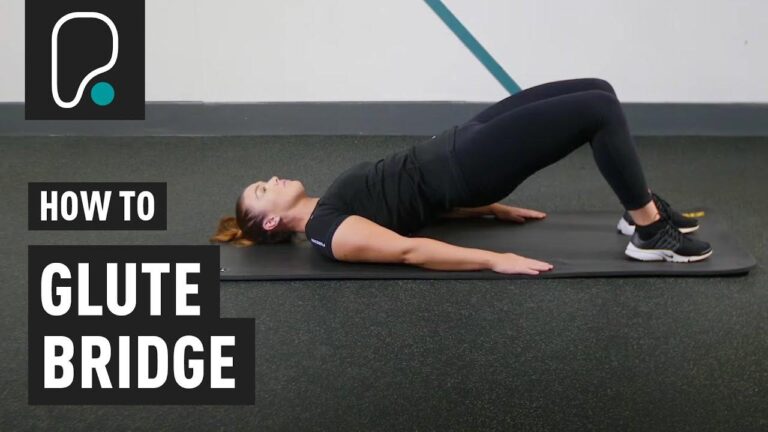When it comes to sculpting a strong, toned posterior, two exercises frequently enough steal the spotlight: glute bridges and hip thrust machines. Whether you’re a gym newbie or a seasoned lifter, deciding which move deserves a spot in your workout routine can be a bit confusing. Both target the glutes, but they come with their own perks, challenges, and equipment needs. In this post, we’ll break down the differences between glute bridges and hip thrust machines, helping you figure out which one fits your fitness goals—and your gym style—best. Let’s dive in!
Table of Contents
- Glute Activation and Muscle Engagement Explained
- convenience and Space Considerations for Your Workout
- tailoring Your Choice to Fitness Levels and Goals
- Pro tips for Maximizing results with Both Options
- To conclude
Glute Activation and Muscle Engagement Explained
When it comes to maximizing your glute gains, understanding how to properly activate thes muscles is crucial. Both glute bridges and hip thrust machines target the gluteus maximus, medius, and minimus, but they do so with slight differences in muscle engagement. Glute bridges rely heavily on body weight and often activate the core and hamstrings alongside the glutes, making them excellent for beginners or those looking to improve mind-muscle connection with a more controlled movement. On the other hand, hip thrust machines allow for increased load and isolation, helping to recruit more muscle fibers through a greater range of motion and offering enhanced activation of the glute maximus specifically.
Effective muscle engagement hinges on proper technique, regardless of whether you choose the glute bridge or the hip thrust machine. Key points for optimal activation include:
- Maintaining a neutral spine to avoid compensation from the lower back
- Driving through the heels to prioritize glute contraction over the quads
- pausing at the top of each repetition to maximize muscle tension
- Ensuring slow, controlled movements to enhance neuromuscular connection
By focusing on these elements, you can ensure that your glutes are firing efficiently, paving the way for stronger, more defined results regardless of your equipment choice.
Convenience and Space Considerations for Your Workout
When it comes to integrating lower body exercises into a home or gym routine, space can be a decisive factor.Glute bridges require minimal room—just enough to lie down flat on a mat—making them perfect for tight living spaces or those who prefer simple setups. You won’t need any bulky equipment, which not only saves physical space but also reduces the clutter of extra gear. Plus, glute bridges are highly versatile: you can easily modify difficulty with resistance bands or added weights without needing a dedicated machine area.
Conversely, hip thrust machines, while fantastic for targeted glute activation, do demand a dedicated space in your workout area. These machines are often bulky and fixed, requiring a designated spot, which may limit options if your gym or home space is limited. Though, if you have the room, the convenience of a machine lies in its stability and guided range of motion. It’s ideal for those seeking efficient, controlled reps without the need to balance the weight manually. Ultimately, your choice will hinge on your available space and how much equipment investment you’re agreeable with.
- Glute Bridges: Minimal space, no equipment, flexible setup
- Hip Thrust Machines: Space-demanding, fixed equipment, stable movement
Tailoring Your Choice to Fitness Levels and Goals
When deciding between glute bridges and hip thrust machines, it’s essential to evaluate your current fitness level and specific goals. For beginners or those easing back into training, glute bridges offer a low-barrier entry point. They require no equipment and allow you to focus on mastering form and muscle activation without overwhelming strain. Simultaneously occurring, if your goal is to build foundational strength and improve hip mobility, glute bridges provide a controlled way to engage the glutes effectively.
On the other hand, hip thrust machines are designed to accommodate progressive overload, making them ideal for intermediate to advanced lifters aiming to maximize glute hypertrophy and strength. With the ability to add precise resistance, these machines help push past plateaus and refine muscular endurance. consider the following when choosing:
- Beginner: Start with bodyweight glute bridges, focusing on form and activation patterns.
- Intermediate: Progress to glute bridges with added resistance bands or dumbbells for more challenge.
- Advanced: Incorporate hip thrust machines to safely increase load, track performance, and build maximal strength.
- Specific Goals: Choose based on whether you prioritize mobility, endurance, or muscle growth.
pro Tips for Maximizing Results with Both Options
To get the most out of your glute bridges and hip thrust machines, focus on perfecting your form before adding weight. For glute bridges, keep your feet flat and shoulder-width apart, driving through your heels while squeezing your glutes at the top of the movement. For hip thrust machines, adjust the seat and pad height to align your hips correctly, ensuring a full range of motion without compromising your lower back. Consistency in tempo—slow and controlled reps—can amplify muscle engagement and reduce injury risk.
Incorporate these strategies into your routine for boosted gains:
- Warm-up with bodyweight bridges to activate your glutes.
- Use progressive overload by gradually increasing resistance or reps.
- Combine both exercises for versatile muscle stimulation.
- Prioritize recovery with stretches focusing on hip flexors and hamstrings.
- Track your progress by noting weights, reps, and any changes in muscle activation.
To Conclude
Whether you’re team glute bridges or swear by the hip thrust machine, the key is finding what works best for your body and goals. Both moves are fantastic for building strength and shaping your posterior chain. Don’t be afraid to mix things up—sometimes a little variety is exactly what your routine needs to keep those glutes firing. So, lace up, get moving, and remember: the best exercise is the one you enjoy and stick with! Here’s to stronger, healthier hips—one rep at a time.

